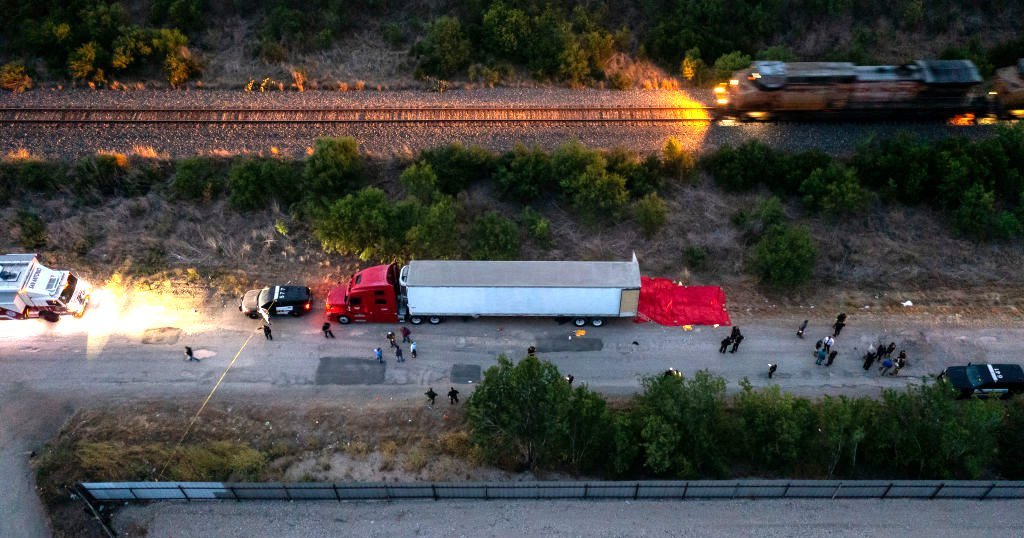The difference between human smuggling and human trafficking – NewsNation Now

(NewsNation) — An initial investigation by law enforcement suggests Monday's tragedy that left 53 migrants dead after they were abandoned in the back of a sweltering truck was likely the result of human smuggling.
But what is human smuggling and how is it different than another common term, human trafficking?
The two crimes can overlap but are notably different in a few ways. Multiple agencies within the Department of Homeland Security are responsible for investigating both offenses but the department defines smuggling as transportation-based and trafficking as exploitation-based.
Human smuggling typically involves individuals who are voluntarily attempting to enter a foreign country illegally. In many cases, those being smuggled pay fees, often thousands of dollars, for fraudulent documents or transportation.
Unlike smuggling, trafficking doesn't require any movement at all and it's not voluntary. Instead, it involves exploiting people, often for the purposes of forced labor or commercial sex acts. Think of it as a modern slavery.
That's not to say those being smuggled aren't also taken advantage of. Experts say drug cartels are profiting off the current border crisis, in some cases making tens of thousands of dollars per person with little regard for human life and safety.
But getting a clear picture of the scope of either crime is notoriously difficult, and in some cases, smuggling can lead to trafficking, according to DHS.
Global estimates from the International Labor Organization, or ILO, indicate that nearly 25 million people are in forced labor situations worldwide. The problem is especially pronounced in Asia and Africa, ILO found.
In North America, the nonprofit Polaris analyzes human trafficking trends using data from the National Human Trafficking Hotline, but even then, the issue is hard to quantify.
“It's very underreported, so the numbers that we normally get and share are just the tip of the iceberg,” said Andrea Rojas, the director of strategic initiatives for Polaris, which works to combat sex and labor trafficking.
Even though many trafficking victims are not migrants, Rojas points out that foreign nationals are very vulnerable, especially when it comes to forced labor.
In March, three men were sentenced to federal prison after they admitted to providing forced labor for farms in south Georgia. Federal prosecutors said the men withheld workers' identification documents and kept them in substandard conditions, comparing the operation to “modern-day slavery.”
Rojas says labor traffickers often target migrants because they can use their temporary immigration status against them. Traffickers count on the fact that many migrants don't speak the language or know how to get help.
Polaris found that the majority of labor trafficking victims were in the country legally on temporary work visas.
In 2020, an estimated 70% of likely labor trafficking victims were foreign nationals, according to Polaris data.
The nonprofit identified agriculture and construction as some of the most common industries for labor trafficking, as well as domestic work such as housekeeping.
Rojas says the stigmatization of migrants plays into the hands of traffickers and can dissuade those who are being abused from seeking help.
“We normalize these exploitative conditions and we think that they're second-class citizens or third-class citizens that kind of deserve that,” Rojas said. “Our real awareness and a complete understanding of this crime is what we really need as a first step.”
You can reach the National Human Trafficking Hotline at any time by calling (888) 373-7888 or texting 233733.
This “Eyes on Trafficking” story is reprinted from its original online location.

ABOUT PBJ LEARNING
PBJ Learning is a leading provider of online human trafficking training, focusing on awareness and prevention education. Their interactive Human Trafficking Essentials online course is used worldwide to educate professionals and individuals how to recognize human trafficking and how to respond to potential victims. Learn on any web browser (even your mobile phone) at any time.
More stories like this can be found in your PBJ Learning Knowledge Vault.
EYES ON TRAFFICKING
This “Eyes on Trafficking” story is reprinted from its original online location.
ABOUT PBJ LEARNING
PBJ Learning is a leading provider of online human trafficking training, focusing on awareness and prevention education. Their interactive Human Trafficking Essentials online course is used worldwide to educate professionals and individuals how to recognize human trafficking and how to respond to potential victims. Learn on any web browser (even your mobile phone) at any time.
More stories like this can be found in your PBJ Learning Knowledge Vault.
